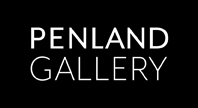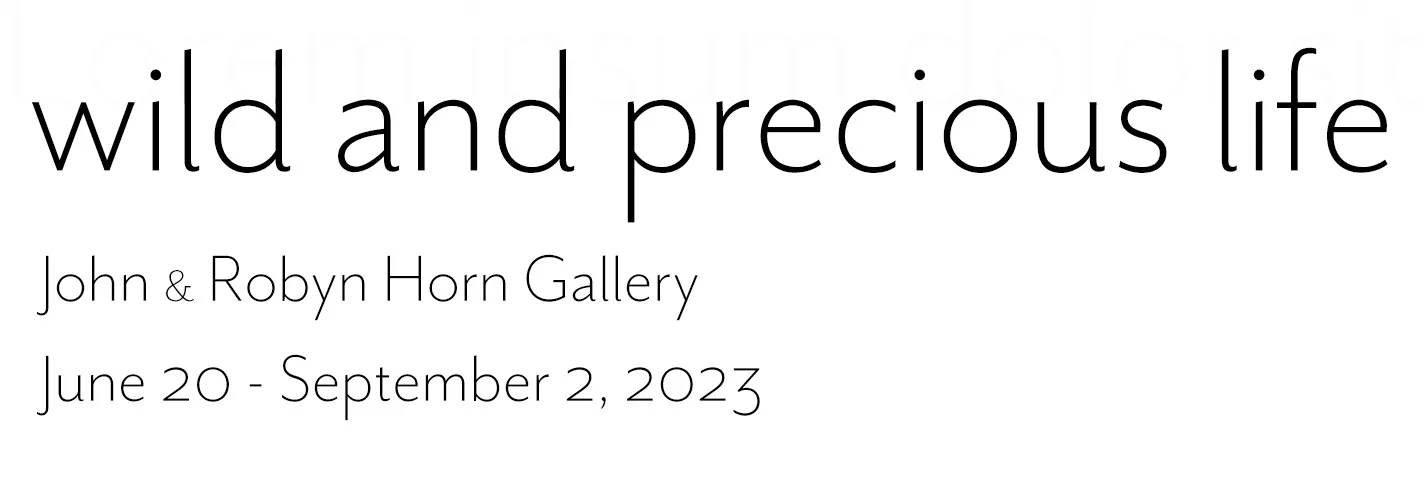
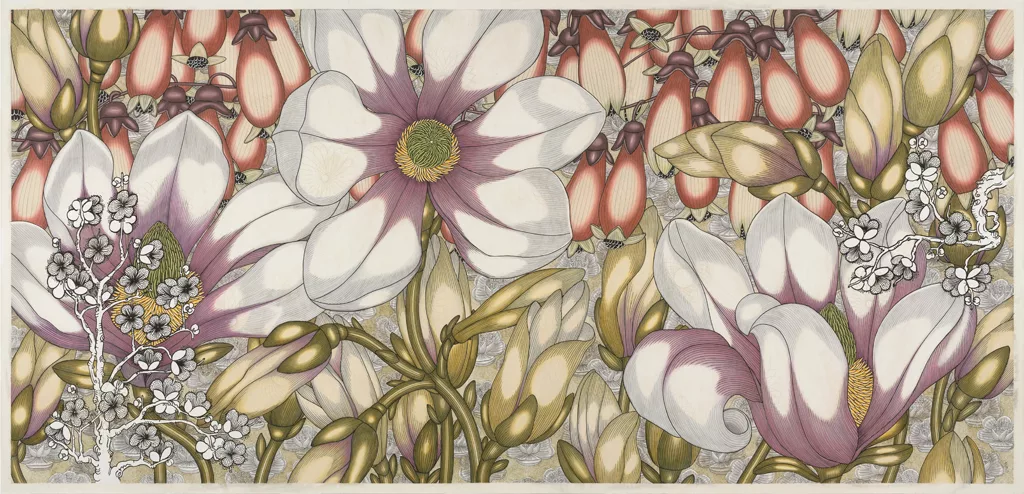
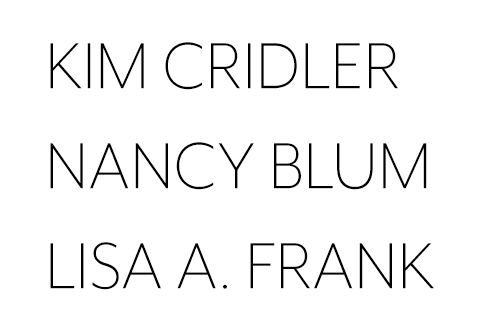
wild and precious life, on view this summer in the Penland Gallery’s John & Robyn Horn exhibition gallery features the work of three highly respected artists with sculptural works in steel, works on paper, and photography.
Kim Cridler’s studio practice focuses on the fabrication of sculptural forms in steel, creating delicate compositions that explore our fragile relationship with the natural world. Cridler writes, “Working with metal and organic materials from the natural world I engage familiar yet symbolic forms like vessels and trees that suggest our desire to collect and contain. More recent works also explore concepts of interdependency. We think of ourselves as apart from the world that has engendered our species, our cultures, and our agency. Yet we are of this nature and the environment that we continue to change.”
Brooklyn-based artist Nancy Blum is known for her large-scale drawings, sculptures, and public art commissions. In this exhibition, Blum works on paper, rendering bold and lush botanical landscapes. With pencil and ink, the artist creates a utopian garden cultivated with flourishing blossoms of preternatural origins, infused with a commanding presence and authority.
Photographer Lisa A. Frank exhibits images from her recent series Captive Splendor. The historic Thorne Miniature Rooms are reimagined as an extraordinary gallery of natural history dioramas, populated with the artist’s images of the animals inhabiting zoos and wildlife sanctuaries in the United States – juxtaposing the wild with the cultivated.
The conceptual thread between the three artists is their potent ability to narrate the boundaries and edges of our coexistence with nature.

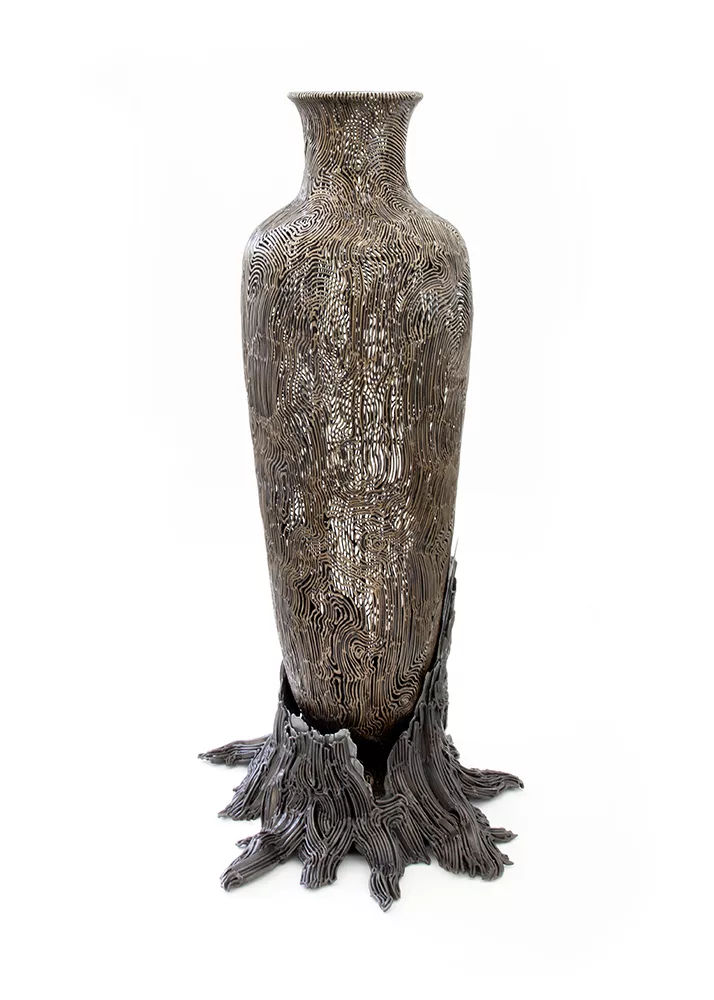
KIM CRIDLER
I was trained as a metalsmith and employ the materials, forms, and decorative impulse of that ancient discipline. Ornament, like craft, is almost never original. Both ornament and craft require models passed down from one generation to the next. But both are always changing, re-imagined by contemporary makers to address the needs of our own times. I am attracted to the idea that the problems, pressures, and pleasures offered to us in this life are not very much different than they have been for thousands of years. Physically and conceptually I appreciate how the modest and repetitive tasks that comprise a life can be both transformative and generative.
Working with metal and organic materials from the natural world I engage familiar yet symbolic forms like vessels and trees that suggest our desire to collect and contain. More recent works also explore concepts of interdependency. We think of ourselves as apart from the world that has engendered our species, our cultures, and our agency. Yet we are of this nature and the environment that we continue to change.
Part of my practice includes direct observation and drawing the animate things from woods and fields around my home. Drawing keeps me engaged in careful looking, gives time and space for a contemplative task, and sharpens my consideration of patterns in even the most ordinary life forms. This practice of observation connects me. It also makes me reflect on our collective desire for certainty; to control and contain that which we are from. Fabricating these works involves a simple and accumulative process of joining small parts together into a larger body to express a sense of movement within still objects and creating a narrative line. In this structure and movement there lies the sense of contingency and potential for instability.
This attentiveness to growth, death, and unexpected transformations has informed current works such as Field Study: Bur Oak with a large felled oak branch lying over an overturned vessel. The vessel is inscribed at the lip and foot with these words by the Roman poet Ovid: “All things change, nothing perishes.” The tree depicted is the bur oak, known for its resilience from both fire and drought. Other works express the potential of change through vessels that appear to have grown around remnants or that have themselves broken into living patterns. Pithos (storage jar) pictures a moment when a rush of finches flies through a large ornamental container as if it were smoke. These works serve as a reminder of our own place in the natural world; no matter how carefully we construct and manage our daily experiences, life will not leave us alone or untouched by change.
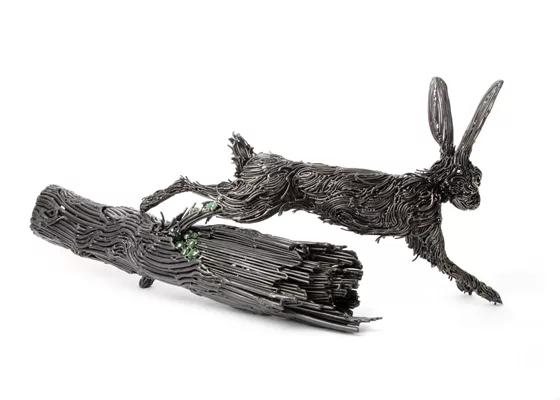
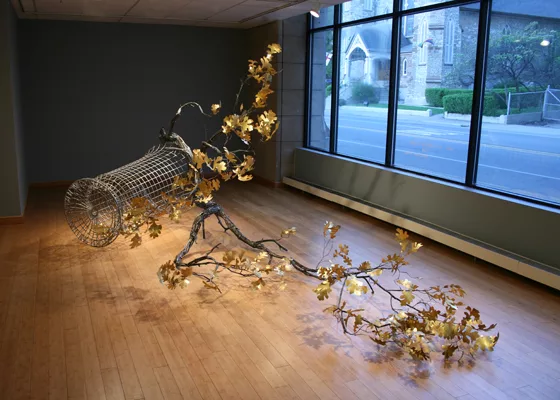

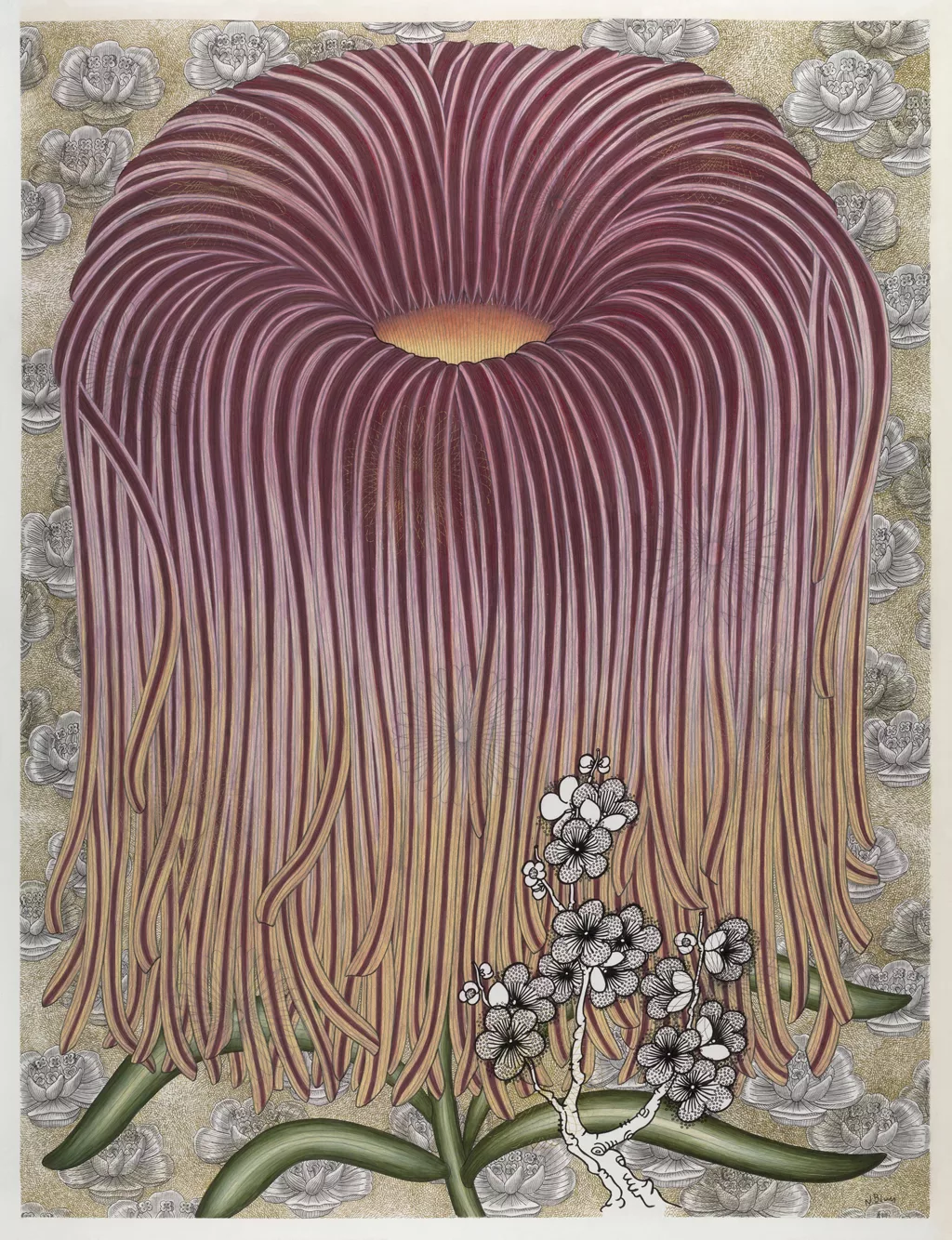
NANCY BLUM
My large‐scale works on paper, rendered in ink, colored pencil, gouache and graphite, portray a fantastic realm in which flowers own the space. I use a variety of 16th and 17th-century botanical images, from Chinese plum blossoms to German botanicals, as starting points for each drawing. Rather than alluding to an actual landscape, I instead combine species of plants in the same drawing that would not customarily exist together in nature. Obsessive handwork creates intricate layers of visual information to be discovered over time and, in this way, the works become a seductive meditation for the viewer.
I use botanical motifs to create images that are universally associated with growth and continuity. My deeper intent is to conjure the ‘flower’ as an active, forceful agent, subverting a culturally conditioned point of view that often deems the ephemeral and the organic as less powerful and of limited value. My ‘wonderland’ presents a view of life that pulses with expansive fecundity; hopefully, it also propels comprehension of the connectedness of all beings within the limitless energy operating throughout this world.
When making art for public spaces, I strive to invest these commissions with similar content, while bringing beauty and a high level of craft to a particular environment. As I conceive and develop each piece, I respond to the specifics of the surrounding architecture, ecosystem, and community in an effort to compellingly meet the needs of the site. My studio practice, in turn, is invigorated by opportunities to design work in relationship to an existing framework, and the special demands and responsibilities this process entails.
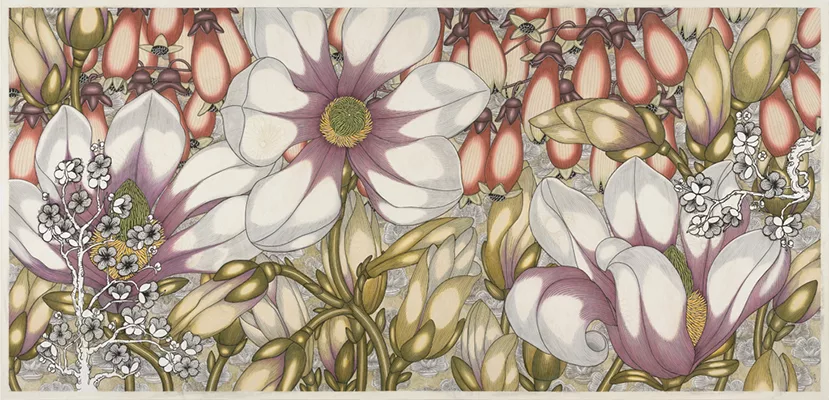
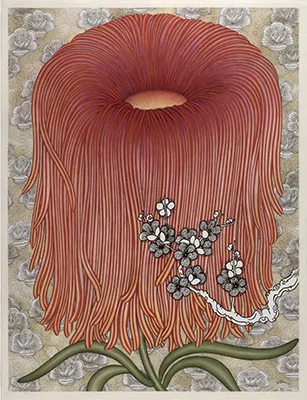

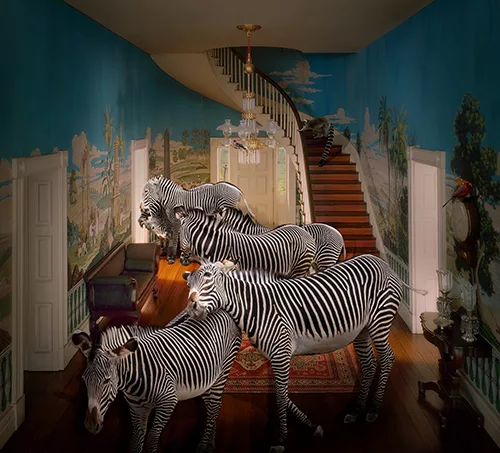
LISA A. FRANK
In November 2020, I began a project photographing animals living in zoos and wildlife sanctuaries in the United States. My intention was to stage these animals within images of the Thorne Miniature Rooms that are on permanent exhibition at the Art Institute of Chicago (AIC) to create updated natural history dioramas that juxtaposed the wild with the cultivated.
Captive Splendor, however, was created during a specific period in American history when a global pandemic, environmental disasters, and social unrest forever altered our sense of home, health, and safety. This added unexpected layers of meaning to the project. We were at least partially “locked-down” as a country during the period that this artwork was made. Although get-out-of-jail-free cards were given to some animals during the pandemic (such as the lucky penguins allowed to stroll through the Shedd Aquarium), life did not change much for animals in captivity who are always
“locked-down.”
Read more about Captive Splendor HERE
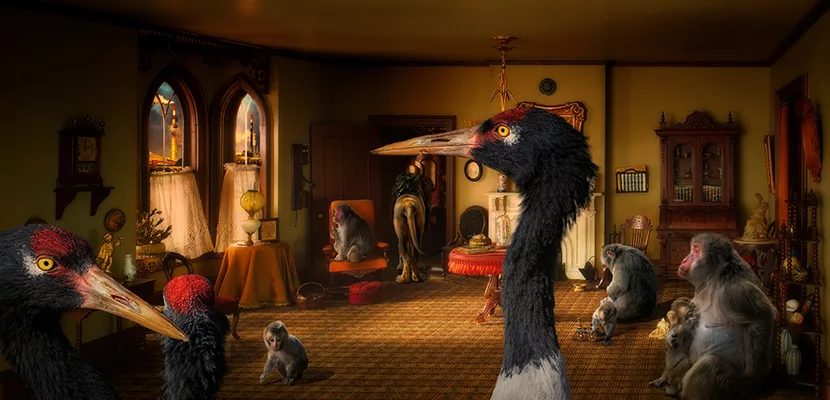
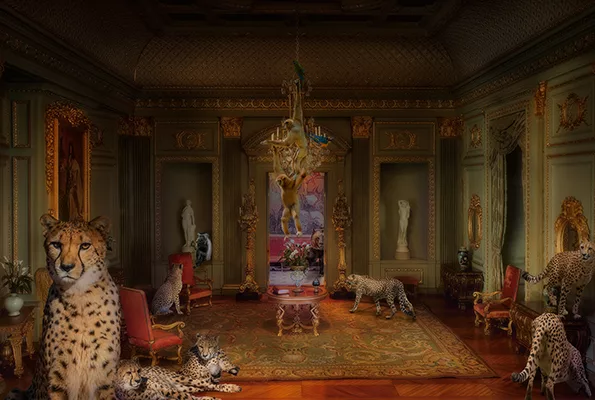
To inquire about works in the exhibition contact us at 828.765.6211 or via email at gallery@penland.org


